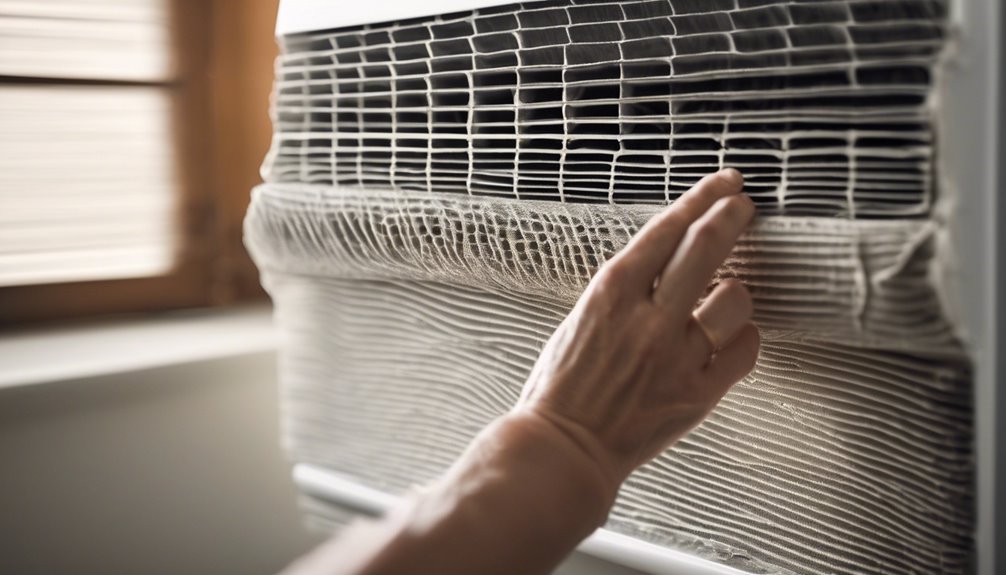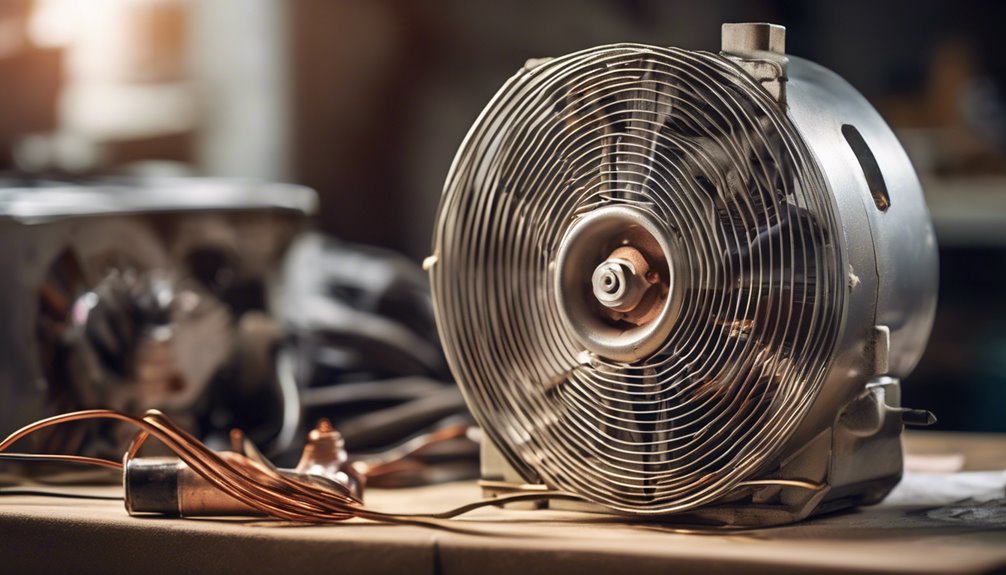To clean your AC filter at home, start by gathering essential supplies like a soft-bristled brush, gentle cleaning solution, and microfiber cloth. Identify the filter location, usually behind the grille, and turn off the AC unit to ensure your safety. Remove the filter, inspect its condition, and soak it in hot water with mild detergent for 30 minutes. Rinse and dry the filter thoroughly before reinstalling it. By following these steps, you'll improve your indoor air quality and AC unit efficiency – and that's just the beginning of what you can learn to get the most out of your AC.
Key Takeaways
- Gather essential supplies, including a soft-bristled brush or vacuum, gentle cleaning solution, and microfiber cloth, to clean the AC filter effectively.
- Identify the filter location, turn off the AC unit, and unplug it to ensure safe and efficient cleaning.
- Inspect the filter, vacuum or brush it gently, and soak it in mild detergent for 30 minutes to remove dirt and dust.
- Rinse the filter thoroughly, dry it completely to prevent moisture buildup, and reinstall it securely to maintain optimal air circulation.
- Regular filter cleaning is crucial for efficient airflow, water conservation, and a healthy indoor environment, as well as to prolong the AC unit's lifespan.
Gathering Essential Supplies
You'll need a few basic supplies to clean your AC filter effectively.
Create a supply checklist to ensure you have everything required for filter maintenance. Start with a soft-bristled brush or a vacuum cleaner to remove loose dust and debris.
You'll also need a gentle cleaning solution, such as a mixture of warm water and mild dish soap. A microfiber cloth or soft sponge is necessary for wiping down the filter.
Gentle cleaning solution, like warm water and mild dish soap, and a microfiber cloth or soft sponge are essential for wiping down the filter.
If your filter has a stubborn buildup, consider adding a filter cleaning spray to your checklist. Finally, have a clean water source nearby to rinse the filter thoroughly.
With these essential supplies, you'll be well-prepared to tackle the task of cleaning your AC filter.
Identifying the Filter Location
You'll need to locate the air filter in your AC unit to clean it, and it's usually hidden from view.
Check behind the grille, as this is a common spot for the filter to be housed. You may need to remove some screws or clips to access the filter location.
Filter Location Check
The air conditioning unit's filter is often hidden from view, so your first step is to track it down.
Check your AC's manual or manufacturer's website for guidance if you're unsure. Typically, the filter is located in a return air grille or behind a removable panel. You might need to remove screws or clips to access it.
Remember, regular filter maintenance is crucial for maintaining good air quality in your home. A dirty filter can circulate pollutants and allergens, making your air quality worse.
Take a moment to inspect the area around your AC unit to get an idea of where the filter might be. Once you've located it, you're ready to move on to the next step.
Behind the Grille
Now that you've got a sense of where the filter might be, it's time to take a closer look behind the grille.
You'll notice that the grille design varies depending on the AC unit model, but most have removable screws or clips.
Take out the screws or release the clips to gently pull the grille away from the unit. Be careful not to touch any internal components.
Behind the grille, you'll find the filter, usually held in place by clips or screws.
Turning Off the AC Unit
You'll need to turn off the AC unit before cleaning the filter to avoid any accidental start-ups or electrical shocks.
Locate the power off switch, usually found on the unit itself or on the remote control, and flip it to the "off" position.
Additionally, unplug the unit from the wall outlet to ensure it's completely powered down.
Power Off Switch
Turn off the air conditioner at the power switch or circuit breaker to prevent any accidental starts while you're working on the filter. This is a crucial step to ensure your safety.
You don't want the AC to suddenly turn on while you're handling the filter, which could lead to injuries or damage to the unit. By switching off the power, you're also promoting energy efficiency, as you won't be wasting energy when the AC isn't in use.
Many modern air conditioners come with an automatic shutdown feature, which helps to conserve energy when not in use. Make sure you've turned off the power switch or circuit breaker before proceeding to the next step.
Unplug the Unit
Unplugging the unit is a crucial step in the cleaning process, as it ensures the air conditioner is completely shut down and won't unexpectedly turn on while you're working on the filter.
This safety precaution is vital to avoid any accidents or injuries. When you unplug the unit, you'll also conserve energy and maintain your AC's energy efficiency.
- Prevents unexpected startups: Unplugging the unit ensures the AC won't turn on while you're working on the filter, which could cause injuries or damage to the unit.
- Saves energy: Unplugging the unit when not in use helps reduce standby power consumption, contributing to energy efficiency and lower energy bills.
- Enhances safety: Unplugging the unit eliminates the risk of electrical shocks or other hazards, creating a safer environment for you and others.
Removing the Filter
The air conditioner's filter is usually located in a slide-out compartment or behind a removable grille, depending on the unit's design. You'll need to identify the filter's location on your specific AC unit. Check your user manual if you're unsure.
| Filter Location | Filter Type | Filter Maintenance |
|---|---|---|
| Slide-out compartment | Disposable | Replace every 1-3 months |
| Behind removable grille | Washable | Clean every 1-2 months |
| In a dedicated filter housing | High-efficiency | Replace every 6-12 months |
| In the AC return vent | Basic | Clean every 2-3 months |
Once you've found the filter, gently pull it out or remove the grille to access it. Be careful not to touch the filter's surface to prevent oil from your skin from damaging it. You're now ready to inspect and clean the filter as part of your regular filter maintenance routine.
Inspecting the Filter Condition
How dirty is your air conditioner's filter, really?
Take a closer look to assess its condition. Hold the filter up to a light source or examine it under natural light. This will help you see the extent of the dirt and debris accumulation.
You should check for:
- Visible dirt and dust: If you can see dirt, dust, or other particles accumulated on the filter, it's a clear sign that it needs cleaning.
- Filter discoloration: If the filter has turned brown, gray, or has developed dark spots, it's an indication of heavy usage and dirt buildup.
- Odors or smells: A dirty filter can harbor mold, mildew, or bacteria, which can cause unpleasant odors. If you notice any unusual smells, it's time to clean the filter.
Vacuuming the Filter
You've inspected the filter and found it's dusty, so now it's time to vacuum it clean.
Use a gentle suction technique to avoid pushing dirt and debris further into the filter, making it harder to clean.
Hold the vacuum cleaner about an inch away from the filter and slowly move it back and forth to loosen the dirt.
Dusty Filter Inspection
As dust and debris accumulate on your AC filter, it's essential to inspect it regularly to ensure your air conditioner runs efficiently.
You'll want to check for signs of dust accumulation, such as a thick layer of dirt or a musty smell.
- Visible dirt and dust: Check if the filter is clogged with visible dirt and dust particles.
- Airflow restriction: See if the airflow from your AC is restricted, indicating a dirty filter.
- Unpleasant odors: Take note of any unpleasant odors coming from your AC, which can be a sign of a dirty filter.
Regular filter maintenance is crucial to maintaining your AC's performance and air quality.
Gentle Suction Technique
Now that you've identified the need for filter maintenance, it's time to clean your AC filter using a gentle suction technique.
Hold your vacuum cleaner a few inches away from the filter and turn it on. Apply gentle suction to the filter, moving the vacuum slowly and evenly across the surface.
Be careful not to press too hard, as this can damage the filter. Use the gentle air pressure to loosen the dirt and dust.
If there are any stubborn particles, use a soft-bristled filter brush to gently sweep them away. Avoid using the vacuum's brushes or beater, as they can damage the filter.
Soaking the Filter
Take the filter out of the vinegar solution and gently tap it against the side of the sink or a hard surface to remove excess liquid.
This step is crucial for effective filter maintenance and water efficiency.
Proper filter maintenance is crucial for efficient airflow and water conservation in your AC unit.
Now, it's time to soak the filter. Fill a large bucket or container with hot water, and add a tablespoon of mild detergent.
Submerge the filter in the soapy water and let it soak for at least 30 minutes.
Here's what you can expect from soaking your AC filter:
- Loosened dirt and debris will be easily removed.
- The filter's airflow will improve significantly.
- Your AC unit will run more efficiently, saving you energy and money.
Rinsing the Filter
You've let the filter soak for a good 30 minutes, and it's time to rinse off the dirt and soap.
Hold the filter under a gentle stream of warm water to remove any remaining dirt and soap residue. Be cautious not to use high water pressure, as it can cause filter damage.
You can also use a hose with a spray nozzle to gently rinse the filter, making sure to keep the nozzle at a safe distance.
Rinse the filter from both sides to ensure all dirt and debris are removed. Continue rinsing until the water runs clear, indicating that the filter is clean.
Drying the Filter
After rinsing the filter, gently shake off excess water to prevent water spots from forming.
You'll want to dry the filter thoroughly to ensure optimal air circulation and prevent moisture buildup, which can lead to mold and mildew growth.
Drying the filter thoroughly is crucial to prevent moisture buildup and the growth of mold and mildew.
To dry the filter effectively:
- Lay the filter flat on a clean towel, allowing air to circulate around it.
- Use a clean, dry cloth to blot the filter, focusing on the areas with the most moisture.
- Allow the filter to air dry completely, which may take several hours or overnight.
Proper filter maintenance is crucial for maintaining efficient air circulation and prolonging the lifespan of your AC unit.
Reinstalling the Clean Filter
With your clean and dry filter in hand, it's time to put it back in its rightful place.
Make sure it's securely fitted into the AC unit, following the manufacturer's instructions. You've just completed a crucial step in filter maintenance, ensuring your air conditioner runs efficiently and effectively.
By reinstalling the clean filter, you're improving your home's air quality, reducing the risk of airborne pollutants and allergens. Remember, regular filter cleaning is essential to maintaining a healthy indoor environment.
Now, turn on your AC and enjoy the fresh, clean air it provides.
Frequently Asked Questions
Can I Clean My AC Filter With a Dishwasher?
You shouldn't wash your AC filter in a dishwasher, as the high heat and harsh detergents can damage its durability. Instead, gently tap out loose debris and vacuum it clean for optimal performance while ensuring dishwasher safety.
How Often Should I Clean My AC Filter?
You should clean your filter every 1-3 months, depending on usage and pets, to ensure optimal airflow and energy efficiency. Regular filter maintenance can delay filter replacement, saving you money in the long run.
What if My AC Filter Is Damaged or Torn?
If your filter's damaged or torn, you'll need to consider filter repair or replacement options. You can't fix it, so don't try; instead, look for a new one that matches your AC's specs, or consult a pro for a custom solution.
Can I Use Bleach to Clean My AC Filter?
You shouldn't use bleach to clean your AC filter as it can damage the material. Instead, opt for a bleach alternative like vinegar or a filter sanitizing spray, which are gentler and effective at removing dirt and germs.
Will Cleaning My AC Filter Really Save Me Money?
You're wondering if cleaning your AC filter will really save you money. Yes, it will! A clean filter boosts filter efficiency, leading to significant energy savings, which translates to lower utility bills and more cash in your pocket.
Conclusion
You've successfully cleaned your AC filter at home! Now, your air conditioner can breathe a sigh of relief, and so can you. With a clean filter, your AC will run more efficiently, reduce energy bills, and improve indoor air quality. Remember to clean your filter every 1-3 months to maintain its performance. By following these simple steps, you'll enjoy a cooler, healthier, and more comfortable living space.



